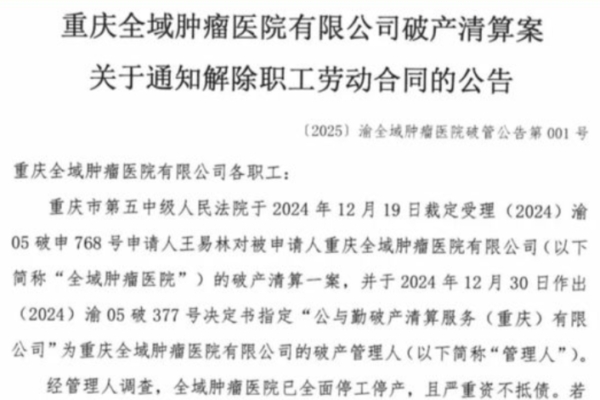In recent news, the Chongqing Integrated Oncology Hospital, which was built with an investment of 3 billion yuan (RMB, Renminbi), has announced bankruptcy and liquidation. The hospital only managed to operate for a short period of two and a half years from its opening.
On January 10, the Chongqing Integrated Oncology Hospital released a public notice declaring bankruptcy and creditors’ claims. It stated that the local court accepted the hospital’s bankruptcy liquidation on December 19 last year, and on December 30, it appointed “Gongyuqin Bankruptcy Liquidation Service (Chongqing) Co., Ltd.” as the bankruptcy administrator.
In another notice titled “Notice of Termination of Employment Contracts for Employees,” the Chongqing Integrated Oncology Hospital also mentioned that the hospital has suspended all operations and production entirely due to severe insolvency. Consequently, the hospital plans to officially terminate labor contracts (or de facto labor relations) with all employees on February 10 this year.
The attached list in the announcement reveals that a total of 132 hospital staff members are awaiting the termination of their labor contracts, mainly including nurses, medical technicians, administrative staff, and physicians.
Public records indicate that the Chongqing Integrated Oncology Hospital is a state-owned mixed-ownership hospital with a national capital background. It is also a tertiary cancer specialized hospital, officially approved for construction in March 2019, started operations in June 2022, underwent expansion in August 2023 with a total investment of 3 billion yuan, covering an area of 1053 square meters with 1700 beds.
This large-scale cancer specialized hospital with an investment of 3 billion yuan went from opening to bankruptcy and liquidation in just two and a half years.
According to reports in mainland China, signals of abnormal operations at the Chongqing Integrated Oncology Hospital were observed as early as October last year. The hospital’s announcement stated that the Health Management Center ceased operations after October 27, 2024.
In June 2021, Beijing Integrated Healthcare, which was involved in the hospital’s investment and construction, withdrew from the hospital investment and transferred the ownership to one of its subsidiary companies.
In April 2022, Integrated Healthcare and its legal representative, Cheng Zheng, faced compulsory enforcement of over 14.42 million yuan, with the actual controller being restricted from spending. Furthermore, it was involved in 27 legal litigations totaling over two million yuan. In November 2022, Integrated Healthcare faced another mandatory enforcement of 55.43 million yuan.
Currently, the phone at the Chongqing Integrated Oncology Hospital cannot be reached. Just three months ago, their official social media account was still posting outpatient scheduling information.
The bankruptcy of the Chongqing Integrated Oncology Hospital has raised concerns in the industry regarding the operational status of cancer specialized hospitals.
In November last year, the Lu’an City Cancer Hospital declared bankruptcy, and its medical assets valued at nearly 300 million yuan were put up for public auction on November 8, 2024. However, the auction did not attract any bids and failed. A second auction with a reduced price of 60 million yuan also ended without a successful bidder. Public records show that the hospital, built 14 years ago, faced bankruptcy auction before even commencing operations.
In December 2021, Guangzhou Nanyang Cancer Hospital Co., Ltd. also declared bankruptcy. Established in 2009, the hospital was once among the top ten cancer specialty hospitals in China and one of the most renowned in the Asian region. At the time of bankruptcy declaration, it had liabilities of over 31 million yuan.
Extended Reports:
Numerous Hospitals in Mainland China Face Bankruptcy and Closure, Exacerbating Expensive Healthcare Issues
Rapid Increase in Patients Amid the Pandemic Raises Questions as Hospitals in Mainland China Close in Bulk

